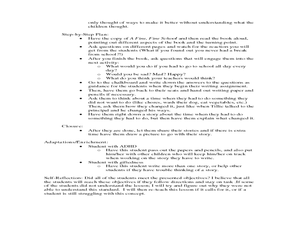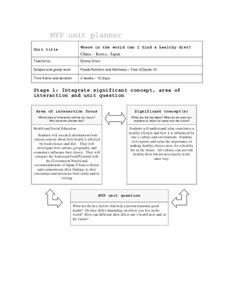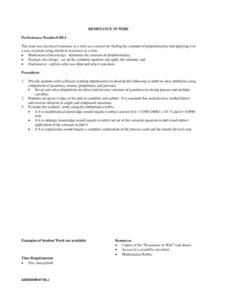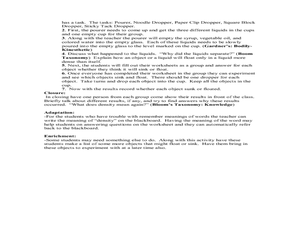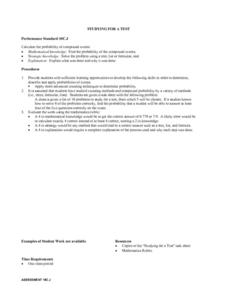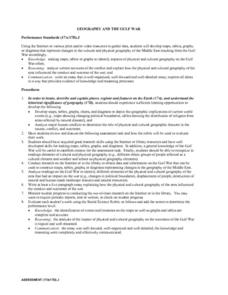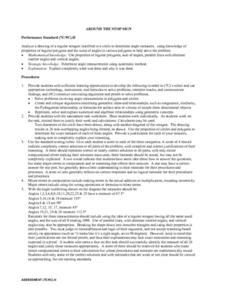Curated OER
Getting Into Shapes: Identifying and Describing Two-Dimensional Shapes
Young scholars examine their classroom to find examples of various types of shapes. After identifying and describing the various shapes, they draw as many as they can on a piece of paper. They organize them into an image based on their...
Curated OER
Let's Meet The Presidents
Create a digital movie documenting research about an American President. Using internet sources, students with special needs gather information about their chosen president. Working in groups, they use this information to create a...
Curated OER
Experience This!
What would you do if you had to go to school all day every day? Tillie tackles this problem in Sharon Creech’s A Fine, Fine School. After a discussion of how Tillie got the principal to change his ways, brainstorm with your class...
Curated OER
Etymology
Learners dissect and build words from parts like prefixes, base words, suffixes, and inflectional endings. Etymology skills help us find the meanings of words by identifying the different parts that constitute them. Class members use...
Curated OER
Analyzing Literature via Literature Circles
Introduce literature circles with Roland Smith's novels. Your seventh graders will see the activity modeled as you read The Three Little Pigs together and apply the format to a Roland Smith novel of their choice. The lesson includes...
Ohio State University
Where in the World Can I Find a Healthy Diet?
What constitutes a healthy diet? In what way is a healthy diet defined and influenced by culture? Groups investigate the community and national resources available in a country, and then design a healthy diet for its citizens.
Curated OER
Out of the Dust: Questioning Strategies
Bloom's Taxonomy is a great way to address the many levels of comprehension. With explanations and examples of each level, you can create questions that focus on knowledge, comprehension, application, analysis, synthesis, and evaluation.
Curated OER
NUMBER MATCH
Students relate the written form to the spoken form of familiar language (e.g., simple greeting, basic vocabulary, numbers, dates, time). They practice counting objects, identifying numbers when presented on flash cards in random order...
Curated OER
FAMOUS NAMES
Learners study some important people and events in French culture. They complete a worksheet and circle every item that is associated with France. They respond to written cues identifying the country's language and culture.
Curated OER
Shapes and Colors All Around
Students tour their school in a scavenger hunt to find primary colors and two and three-dimensional shapes. Students take digital pictures of the colors and shapes they find and create a class book of the pictures.
Curated OER
The Dred Scott Case (1857)
Students read and discuss Dred Scott v. Sandford Supreme Court case, describe in writing Constitutional principles and results of case, explain how Supreme Court decision may have helped further tensions between states, and answer...
Curated OER
Resistance in a Wire
Students find the constant of proportionality and apply it to a situation. They use the electrical resistance in a wire as a context for finding the constant of proportionality. In addition, they write an explanation and justification of...
Curated OER
Liquids: Floating and Sinking
Third graders conduct an experiment. In this floating and sinking liquids lesson, 3rd graders discuss density and investigate it using syrup, vegetable oil and colored water. Students observe the results and complete a worksheet.
Curated OER
ART PROJECT
Eighth graders, after researching the properties of graphs of conic sections, absolute value and inverse relations, make a drawing of precise functions and relations from a specified list of equations. The final design should analyze the...
Curated OER
Studying for a Test
Middle schoolers calculate the probability of compound events. They solve the problem using a tree, list of formulas and explain what was done and why it was done. Students develop the following skills in order to determine, describe...
Curated OER
If I Could Have Lived in Another Time or Culture
Third graders develop multi-paragraph compositions. They include an introduction, first and second level support, and a conclusion. They use a variety of sentence structures (e.g., simple, compound/complex) and sentence types (i.e.,...
Curated OER
Geography And The Gulf War
Young scholars develop maps, tables, graphs, charts, and diagrams to depict the geographic implications of current world events, and analyze major human conflicts to determine the role of physical and cultural geographic features in the...
Curated OER
Family Names
Young scholars draw a family tree. They label familiar items (e.g., family members, classroom objects, and pets). Pupils are given a copy of the worksheet "Family Name," they draw a family tree, label themselves and at least 10...
Curated OER
WRITE A STORY
Third graders compose two or more simple sentences in response to a picture. They construct sentences and produce captions with 3 or more sentences that extend the subject/verb pattern. They demonstrate age appropriate correct use of...
Curated OER
Measuring the Flagpole
Studets practice problem solving and comparison of quantities, ratios and prproportions. They develop a plan for determining the height of a flagpole complete with drawings and calculations. In addition, they complete a written...
Curated OER
Around The Stop Sign
Young scholars analyze a drawing of a regular octagon inscribed in a circle to determine angle measures, using knowledge of properties of regular polygons and the sums of angles in various polygons to help solve the problem. They use...
Curated OER
Why Isn't It 50-50
Young scholars comprehend the difference between the outcome of the experiment and the outcome that they expected. They analyze outcome of probability experiment and compare theoretic and empirical results. Pupils discuss the difference...
Curated OER
DIVISION OF LABOR
Students define division of labor. They read books about how things are produced to help illustrate the concept of division of labor. They suggest other items that could illustrate division of labor. They create a sample flow chart...
Curated OER
INFORMATION DETECTIVE
Students generate 2 or more questions without teacher support. They state known information and make personal connections without teacher support. They select two or more resources to answer his/her question. They distinguish...




